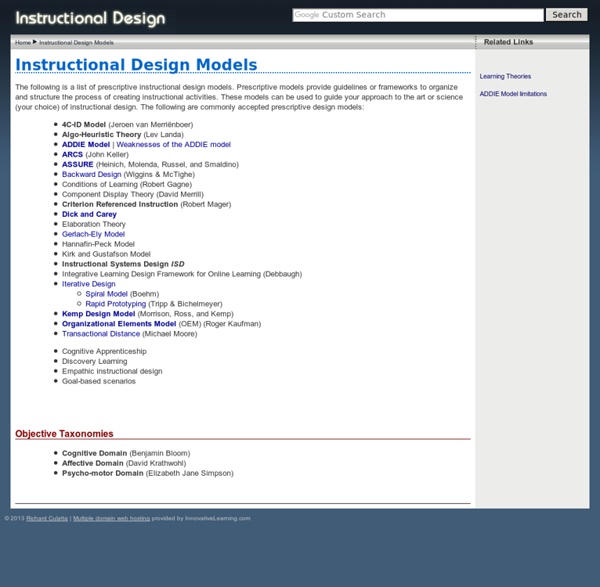Instructional Design Models
The following is a list of prescriptive instructional design models. Prescriptive models provide guidelines or frameworks to organize and structure the process of creating instructional activities. These models can be used to guide your approach to the art or science (your choice) of instructional design. Cognitive Domain (Benjamin Bloom) Affective Domain (David Krathwohl) Psycho-motor Domain (Elizabeth Jane Simpson)
Burleson's Grad Work - Models_Theories
Various Models and Theories I want to be able to reference quickly. Nine Events of Instruction Design Model Heinich, Molenda, Russell & Smaldino Model (Newby, Stepick, Lehman and Russell Model) Model comparing selected characteristics of Classroom, Product and Systems oriented models Source: p. 17 Model for Designing Instruction Revised Taxonomy "Terminology changes "The graphic is a representation of the NEW verbage associated with the long familiar Bloom's Taxonomy.
Kirkpatrick's Four-Level Training Evaluation Model - MindTools.com
© GettyImagesskynesher Make sure that your training programs are relevant, engaging and effective. Any time you deliver training to your team, you need to know how effective it's been. Are your people putting their learning into practice? And, is it positively impacting their role and the wider organization? Kirkpatrick's Four-Level Training Evaluation Model can help you to answer questions like these. In this article, we'll explore Kirkpatrick's model and how to apply it. Understanding Kirkpatrick's Four Levels Donald Kirkpatrick, former Professor Emeritus at the University of Wisconsin, first published his model in 1959. Each successive level of the model represents a more precise measure of the effectiveness of a training program. In 2016, James and Wendy revised and clarified the original theory, and introduced the "New World Kirkpatrick Model" in their book, "Four Levels of Training Evaluation." The four levels are Reaction, Learning, Behavior, and Results. Level 1: Reaction Note: Tip:
The LMS Isn't Dead Yet
Opinion The granddaddy of learning technology systems is showing its age. Better defining how it fits in the modern learning ecosystem will ensure it continues to play a valuable role. Mike Rustici, founder and CEO, Watershed. There’s a lot of talk about the fate of the LMS these days. For example, read the battling viewpoints expressed on this site between Carol Leaman of Axonify and Joe Majors of Saba. As with most contentious debates, the truth lies somewhere between the extremes. We need to start by defining what we mean when we say LMS. Delivering learning experiences and managing enrollments (largely e-learning).Managing instructor-led training, or ILT, and classroom resources.Keeping track of who has done what, largely for compliance purposes. At its core, the LMS should perform these three functions really well. But these issues aren’t really the LMS vendors’ fault. In other words, the LMS isn’t dead. That’s a good thing for all of us, including the LMS vendors.
Related:
Related:



